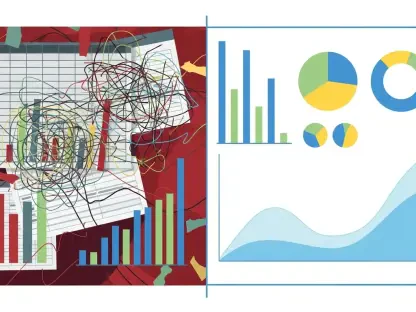Introduction to Data-Driven HR: A New Era for Workforce Management
Imagine a world where human resources departments can predict talent shortages before they cripple operations, or identify the exact skills needed for a rapidly shifting market with pinpoint accuracy. This is no longer a distant dream but a tangible reality for organizations embracing data analytics in HR. The role of HR has evolved dramatically, moving beyond administrative tasks to become a strategic powerhouse that leverages data to reshape workforce management. This transformation is driven by the need to navigate complex challenges like talent scarcity and digital disruption, positioning HR as a critical partner in organizational growth.
Historically, HR relied on intuition and manual processes for decisions about hiring, retention, and development. Today, a seismic shift toward data-informed strategies allows for more precise, evidence-based actions that align with business goals. Research from leading firms like McKinsey and Deloitte underscores this change, showing that companies using analytics in HR achieve measurable improvements in efficiency and employee outcomes. This evolution reflects a broader recognition that data is not just a tool but a foundation for addressing modern workforce dynamics.
The significance of this shift cannot be overstated, as organizations grapple with rapid technological advancements and changing employee expectations. Data-driven HR offers a pathway to anticipate needs, optimize resources, and foster resilience in an unpredictable landscape. Insights from thought leaders highlight that analytics empowers HR to transition from reactive problem-solving to proactive planning, a critical advantage in sustaining competitive edge and driving long-term success.
The Power of People Analytics: Trends and Insights
Emerging Trends Shaping Data-Driven HR
A wave of innovation is sweeping through HR, with artificial intelligence and predictive analytics leading the charge in redefining processes like recruitment and performance management. These technologies enable organizations to forecast hiring needs and employee turnover with unprecedented accuracy, streamlining operations in ways traditional methods cannot match. The integration of such tools marks a pivotal moment, as HR shifts focus from merely managing people to strategically shaping the workforce.
Another transformative trend is the departure from static job roles toward skills-based workforce planning. This approach prioritizes identifying and cultivating capabilities over rigid job titles, allowing companies to adapt to evolving demands with greater flexibility. As market needs change, this mindset facilitates internal mobility and targeted upskilling, ensuring talent remains aligned with organizational priorities in a dynamic environment.
Additionally, the demand for human skills such as communication and collaboration is surging, even in an AI-driven era. While technical expertise remains vital, the unique value of interpersonal abilities is gaining prominence as technology handles more routine tasks. This balance reflects a broader market driver: the need for agility in talent management amid rapid workforce changes, pushing HR to nurture both human and digital competencies.
Quantifying the Impact: Data and Projections
The tangible benefits of data-driven HR are striking, with research from McKinsey revealing an 80% increase in recruiting efficiency, a 25% boost in productivity, and a 50% reduction in attrition for organizations leveraging analytics. These figures illustrate how data transforms HR from a cost center into a value driver, delivering outcomes that resonate across the enterprise. Such statistics highlight why investment in people analytics is no longer optional but essential for sustained growth.
Despite these advantages, maturity levels in data practices remain uneven, with Deloitte findings indicating that 83% of companies lag in advanced analytics adoption. This gap suggests a vast opportunity for improvement, as many still rely on fragmented systems that hinder comprehensive insights. Bridging this divide requires a concerted effort to build integrated data frameworks capable of supporting strategic decision-making.
Looking ahead, projections from the World Economic Forum estimate that 39% of core worker skills will change by 2030, signaling a profound shift in workforce requirements. Data-driven HR holds the potential to proactively address these talent gaps, using predictive tools to map future needs and align resources accordingly. This forward-looking capability positions analytics as a cornerstone for navigating the complexities of tomorrow’s labor market.
Challenges in Adopting Data-Driven HR Practices
Adopting data-driven practices in HR is fraught with obstacles, chief among them being fragmented data systems and outdated infrastructure. Many organizations still depend on static tools that fail to capture the dynamic nature of workforce trends, resulting in incomplete or unreliable insights. This foundational weakness often derails efforts to implement analytics effectively, stalling progress before it can gain momentum.
Data silos present another significant hurdle, as information scattered across departments prevents a unified view of the workforce. Without integration, HR struggles to draw meaningful conclusions or align strategies with broader business objectives, perpetuating inefficiencies. Overcoming these barriers demands a commitment to harmonizing data sources, a process that requires both technological investment and cross-functional collaboration.
Moreover, the risk of data misuse or manipulation looms large, underscoring the need to anchor analytics in clear business and people strategies. Transformation in this space is inherently time-intensive, as building sustainable data foundations does not happen overnight. Experts suggest focusing on incremental progress—prioritizing consistent data definitions and integrated reporting—to create a robust platform for long-term success, rather than chasing quick fixes with limited impact.
Navigating the Compliance and Ethical Landscape in HR Analytics
The use of data in HR brings with it a complex web of regulatory and ethical considerations, particularly around data privacy and security. Employee information is highly sensitive, and mishandling it can erode trust and invite legal repercussions. Organizations must prioritize safeguarding this data, ensuring that systems and practices adhere to stringent standards to protect individual rights.
Compliance with relevant laws and regulations is non-negotiable when deploying HR analytics tools, as failure to do so can result in significant penalties and reputational damage. This necessitates a thorough understanding of applicable frameworks, which vary by region and industry, and embedding them into data strategies from the outset. Such diligence not only mitigates risk but also reinforces accountability within the organization.
Transparency in data practices is equally critical to maintaining trust among employees and stakeholders. Ethical handling of information—ensuring it is used fairly and communicated clearly—builds confidence in HR initiatives. As regulations continue to evolve, their influence on the adoption of analytics tools will shape implementation approaches, requiring HR leaders to stay agile and informed to balance innovation with responsibility.
The Future of HR: Innovations and Opportunities Ahead
Envisioning the trajectory of data-driven HR reveals a landscape rich with innovation, particularly through advancements in artificial intelligence and predictive tools. These technologies promise to deepen workforce intelligence, enabling organizations to anticipate trends and tailor strategies with remarkable precision. Such developments are poised to redefine how talent is sourced, developed, and retained in an increasingly competitive market.
Emerging disruptors, including new technologies and shifting employee expectations, will further influence HR’s evolution. As workers demand more personalized experiences and flexibility, data insights offer a means to customize engagement and career paths. This focus on individual needs, alongside broader organizational goals, highlights areas like internal mobility and upskilling as key growth opportunities for the future.
Global economic conditions and ongoing innovation will also play a pivotal role in shaping HR practices. Economic fluctuations may accelerate the push for efficiency through analytics, while breakthroughs in data tools could unlock new ways to address workforce challenges. Staying ahead of these currents will require HR to remain adaptable, leveraging data not just for immediate gains but to build a resilient, forward-thinking function.
Conclusion: Building a Sustainable Data-Driven HR Future
Reflecting on the journey of data-driven HR, it becomes evident that its transformative potential is matched by substantial, measurable benefits in efficiency, productivity, and retention. The challenges, from fragmented systems to ethical dilemmas, demand a steadfast commitment to achieving high data maturity over time. These hurdles underscore that success in this realm is not a quick win but a sustained effort rooted in strategy and patience.
Looking back, the insights gained point to actionable steps for HR leaders that go beyond initial adoption. Investing in robust data foundations emerges as a cornerstone, ensuring that systems can support integrated, reliable insights. Prioritizing skills-based planning also stands out as a vital approach to prepare for inevitable workforce shifts, while balancing technical and human skills offers a nuanced path to holistic development.
Ultimately, the path forward crystallizes around positioning HR as a strategic partner in organizational growth through analytics. Recommendations include fostering cross-departmental collaboration to dismantle data silos and embracing predictive tools to anticipate future needs. By committing to these steps, HR leaders can navigate complexities with confidence, driving innovation and resilience in a landscape that continually evolves.









